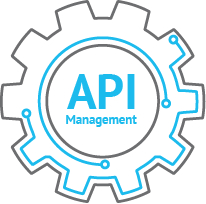Contents
What is API Management
API management involves overseeing every aspect of an API and its lifecycle, starting from when it’s created until the day it’s retired. The process includes designing, publishing, documenting, and analyzing APIs for performance, security, and utility.
With this management approach, you get API gateways to control traffic flow, a developer portal for authenticating access controls, and the ability to compile usage statistics and offer technical documentation to developers with an analytics platform in place.
With interconnected software becoming more common, API management becomes integral to any organization’s digital strategy.
Why API Management is Important
Applications communicate through APIs, allowing data from one source to be shared across platforms. Thus, the importance of maintaining efficient, secure, and scalable integrations cannot be undermined. API management comes into play when keeping everything running smoothly between systems and services.
Here is why effective API management solutions are crucial if you want your organization to thrive:
In an ever-evolving cyber threat landscape, the robustness of your API security is improved through strong API management. Comprehensive authorization and encryption procedures guarantee total protection against unauthorized access or information breaches. The robustness of the above posture has a direct bearing on the privacy of data, which may easily trade hands using APIs when shared among interconnected systems.
When you increase your dependency on APIs, there usually arises a need for an effective scaling mechanism supported by reliable API management tools within your infrastructure so that the demands do not hamper operations nor reduce quality user experience.
API management also goes beyond operational oversight to provide strategic insights through analytics. Organizations can identify usage patterns by analyzing API usage data, pinpoint potential bottlenecks, and derive actionable insights to enhance API efficiency and performance. Therefore, organizations can identify usage patterns by analyzing API usage data and its capacity to meet market demands.
The presence of efficient API lifecycle management best practices ensures that your APIs constantly evolve in line with both technological advancements and business objectives. Effective lifecycle management keeps APIs relevant, secure, and compliant with industry standards from development or deployment up to deprecation periods, thus maximizing their value proposition over time.
Thorough and usable documentation is part of the scope of work for API management, hence providing a more comprehensive developer experience and promoting a developer-centric ecosystem. Openness and accessibility are two key terms here because they allow developers to easily learn how to integrate with your API before building applications on top of it.
API management simplifies navigating the complex landscape of legal and regulatory requirements. It helps you avoid legal problems by putting necessary controls in place, including compliance checks and audits, that ensure all your activities are carried out under applicable laws and industry standards, leading to stakeholder confidence.
For your company to have an effective API strategy, you must understand what constitutes promising API management approaches. When carefully implemented, it ensures that these initiatives make sound technical sense and are perfectly aligned with other larger organizational goals, including digital transformation efforts.
API Management Best Practices
Implementing the right API management strategies and practices is essential for maximizing the effectiveness of your API initiatives.
Here are several key API management best practices to consider:
Implementing Effective Rate Limits
Effective rate limit implementation is essential to managing APIs that provide reliable access to everyone in need. Your rate limits should be adjusted according to the overall system load and user behavior, which provides some elasticity, maintaining optimal service levels while enabling dynamic rate-limiting strategies.
Strategies for Efficient API Versioning
Efficient versioning requires an understanding approach that can handle changes and updates seamlessly not to disrupt what has been built around your application programming interface ecosystem.
These strategies can be used depending on how specific needs are addressed by APIs, such as a URL versioning strategy, header versioning approach, and custom media types framework inclusive.
In addition, if developers are informed about future changes as soon as possible, they have a better chance of adapting and minimizing the impact on existing applications.
Crafting Comprehensive API Documentation
The purpose of writing comprehensive documentation is to empower developers with an excellent API that uses the least painful approach. Such updates include reflecting the current state of the API through new features while deleting outdated ones.
By incorporating interactive features like API explorers or sandboxes, your users are allowed to try out and understand how your API works thus accelerating the learning process.
Enhancing API Monitoring and Analytics
Enhanced monitoring adds insights into the behavior of API users, its efficiency at any given time, and the overall healthiness of an API ecosystem beyond basic metrics. With these advanced analytics, you can also determine how different patterns can improve your API’s performance, enabling you to make better decisions.
Real-time monitoring tools are used here to alert you promptly about anything wrong happening, which would lead to immediate action before service quality deteriorates.
Planning for API Scalability
Planning for scalability involves forecasting future growth and designing your infrastructure in such a way that it accommodates it without negatively affecting performance.
This could involve using cloud services for elasticity, distributing load via microservices, and employing efficient data caching techniques. Such plans ensure that your API can sustain increased popularity and handle a growing number of users without compromise.
Governance Through API Lifecycle Management
Holistic governance through the lifecycle management of APIs ensures that they adhere to the organization’s strategic goals, meet compliance requirements, and conform to security standards at all stages. This includes coordinating across teams, implementing standard development practices, and conducting regular performance reviews.
Lifecycle management fosters a culture of continuous improvement, where APIs evolve in alignment with the organization’s objectives and user needs.
Securing External API Integrations
In today’s interconnected digital environments, businesses must secure their application programming interface integrations against potential harm or problems arising from unforeseen events like data breaches.
Thus, secure protocols should be established when integrating third-party services, comprehensive risk assessments should be performed, and strict compliance postures maintained. These measures protect sensitive information and help build users’ and partners’ trust by committing to security and privacy.
Future Trends in API Management
It is important to adapt to future API management improvements as this will position us better to prepare for those changes, which are all about technological changes and market shifts.
Different strategies might include incorporating new security technologies, using artificial intelligence to make APIs smarter, or exploring how quantum computing might change API performance.
When your orientation is towards the future, you will always have an upper hand against your competitors because your team knows what will happen next.
An organization’s ability to innovate comes about when its culture supports creativity and new ideas. This can lead to new perspectives on how APIs are designed, deployed, and managed, which could set it apart in a cluttered market.
API Security Best Practices: Protect Your Data
Conclusion
An API management solution is one of the fundamental aspects of effective digital strategies. It also stimulates innovation and immensely improves user experience.
By keenly following the stated API lifecycle management best practices, organizations can guard themselves against emerging API threats, security breaches, and potential vulnerabilities and expose their APIs to a constantly changing business environment.
The path of API management, strategic vision, and operational muscle memory are geared towards using APIs to drive business objectives. This entails a commitment to maintaining the status quo and improving the engagement of an API, its security features, and its functionality. It is an ongoing process that calls for constant attention, reflection, and adjustment if we are to remain competitive.
This essentially means being proactive in this era of ever-changing digital dynamics. Therefore, anticipating future trends, understanding the implications of new technologies, and preparing your APIs to leverage such developments will put your company at the forefront in seizing opportunities and facing challenges confidently.
To further explore how to optimize your API management strategy and ensure your APIs are future-ready, visit Devcom’s API development services.











